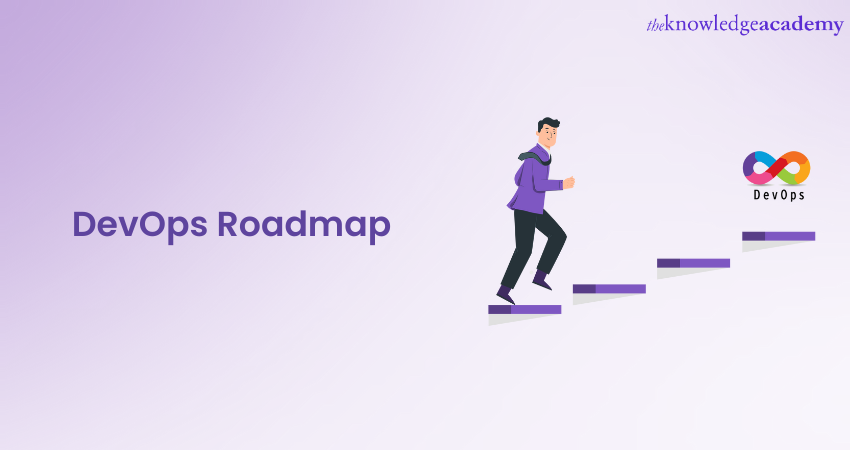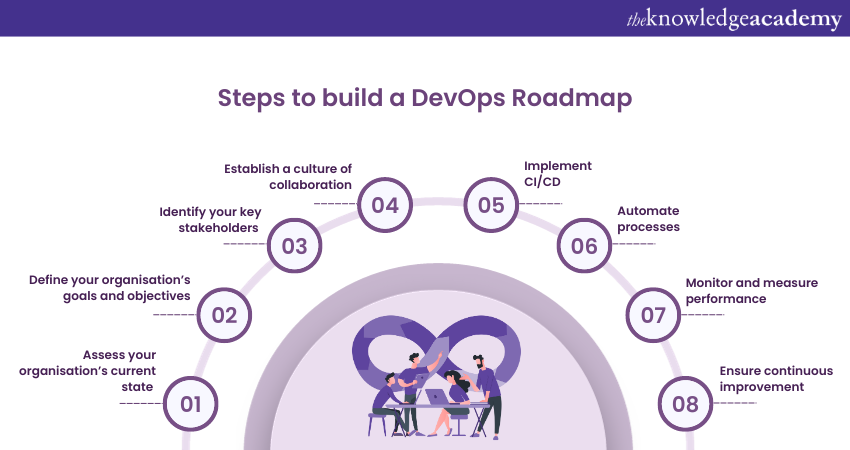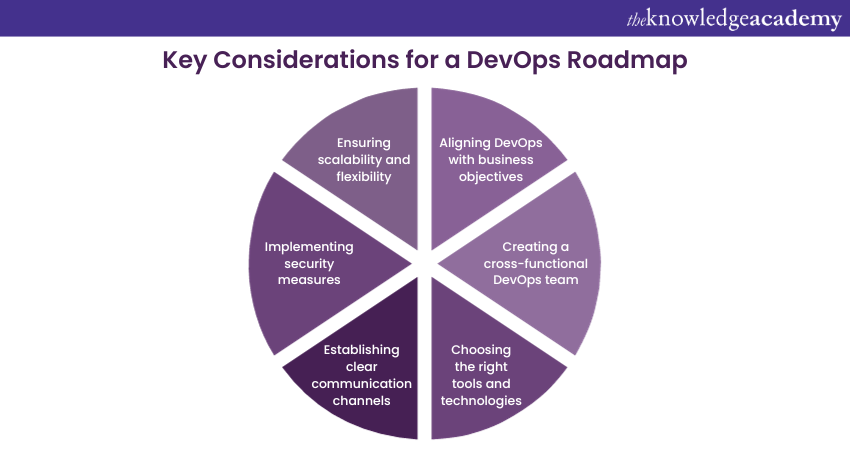We may not have the course you’re looking for. If you enquire or give us a call on + 800 908601 and speak to our training experts, we may still be able to help with your training requirements.
Training Outcomes Within Your Budget!
We ensure quality, budget-alignment, and timely delivery by our expert instructors.

The modern-day organisations continuously strives to improve their software development and delivery processes. To achieve this, organisations adopt DevOps – a methodology that combines development and operations. It helps streamline software delivery, enhance collaboration and drive organisational success. Organisations must adopt a suitable DevOps Roadmap as their first step towards an effective and successful implementation.
Over the years, the DevOps methodology has garnered quite the reputation, owing to its ability to boost software development. If you are someone keen to understand the intricacies surrounding DevOps then this blog is for you. This blog will tell you all you need to know about building a successful DevOps Roadmap, and the key factors you must consider before building one.
Table of Contents
1) What is DevOps?
2) Benefits of DevOps
3) How to build a DevOps Roadmap?
a) Assessing the current state
b) Defining goals and objectives
c) Identifying key stakeholders
d) Establishing a culture of collaboration
e) Implementing Continuous Integration/Continuous Deployment (CI/CD)
f) Automating processes
g) Monitoring and measuring performance
h) Continuous learning and improvement
4) Key considerations for a DevOps Roadmap
5) Conclusion
What is DevOps?
Before getting into the steps to implement a DevOps Roadmap, let us first understand What is DevOps. DevOps represents a collaborative culture merging development and operations, aiming to streamline software development and deployment processes. It's a methodology that fosters collaboration, communication, and integration between Software Developers and IT professionals.
DevOps enhances agility by automating and optimising the delivery of software products. It emphasises Continuous Integration and Continuous Delivery (CI/CD) pipelines, ensuring faster, more frequent releases. The approach encourages shared responsibility, promoting practices emphasising automation, monitoring, and rapid response to change. Ultimately, DevOps seeks to bridge the gap between software development, IT operations, and business requirements, promoting a more efficient and effective software development lifecycle .

Benefits of DevOps
Here are the top Benefits of DevOps
1) Enhanced collaboration: DevOps encourages collaboration between development and operations teams, breaking down silos and promoting a culture of shared responsibility and communication.
2) Faster delivery of software: It enables faster delivery of applications and updates through automation, continuous integration, and deployment, reducing the time between writing code and deploying it to production.
3) Increased reliability and stability: DevOps practices, such as continuous monitoring and testing, enhance the reliability and stability of software by identifying and fixing issues in the early stages of development.
4) Improved efficiency: Automation and standardisation of processes reduce human error, streamline workflows, and increase the overall efficiency of the development and deployment pipeline.
5) Greater scalability and flexibility: DevOps allows for more scalable and flexible systems, enabling quick adaptation to changing business needs and ensuring the infrastructure can grow in tandem with the organisation's demands.
How to build a DevOps Roadmap?

Building a DevOps Roadmap is a crucial step toward implementing an effective and successful DevOps strategy within your organisation. This section will examine each step of building a roadmap, providing valuable insights and considerations:
Assessing the current state
Before starting your DevOps journey, it's essential to assess your organisation's current state of software development and operations. This assessment will help you understand the existing processes, identify pain points, and determine areas that require improvement. Conduct a thorough evaluation of your software development lifecycle, infrastructure, release processes, collaboration practices, and toolchain. This assessment will serve as a baseline for your transformation.
Defining goals and objectives
Clearly defining your goals and objectives for adopting DevOps is crucial for creating an effective roadmap. These goals could include reducing time to market, improving product quality, enhancing team collaboration, increasing deployment frequency, or aligning with business objectives. It is vital to ensure that your goals are Specific, Measurable, Achievable, Relevant, and Time-bound (SMART). This clarity will guide your roadmap to DevOps and help measure your success along the way.
Identifying key stakeholders
Identifying key stakeholders early on is essential for successful DevOps implementation. These stakeholders can include executives, department heads, developers, operations teams, quality assurance personnel, and other relevant individuals. Engaging these stakeholders from the beginning and obtaining their buy-in and support is critical. Collaborate with them to understand their pain points, expectations, and goals and involve them in decision-making processes. Their active involvement will cultivate a sense of ownership and drive the success of your DevOps initiative.
Establishing a culture of collaboration
One of the fundamental principles of DevOps is promoting a culture of collaboration and shared responsibility between development and operations teams. Breaking down silos and encouraging cross-functional collaboration are essential. Emphasise the importance of open communication, knowledge sharing, and empathy between teams. Encourage regular meetings, joint problem-solving sessions, and create channels for effective communication. This collaborative culture will lay the foundation for a successful DevOps implementation.
Want to take the next step in your DevOps journey? Check out our Certified DevOps Professional (CDOP) Course today!
Before starting your DevOps journey, it's essential to assess your organisation's current state of software development and operations. This assessment will help you understand the existing processes, identify pain points, and determine areas that require improvement. Conduct a thorough evaluation of your software development lifecycle, infrastructure, release processes, collaboration practices, and toolchain. This assessment will serve as a baseline for your transformation.
Defining goals and objectives
Clearly defining your goals and objectives for adopting DevOps is crucial for creating an effective roadmap. These goals could include reducing time to market, improving product quality, enhancing team collaboration, increasing deployment frequency, or aligning with business objectives. It is vital to ensure that your goals are Specific, Measurable, Achievable, Relevant, and Time-bound (SMART). This clarity will guide your roadmap to DevOps and help measure your success along the way.
Identifying key stakeholders
Identifying key stakeholders early on is essential for successful DevOps implementation. These stakeholders can include executives, department heads, developers, operations teams, quality assurance personnel, and other relevant individuals. Engaging these stakeholders from the beginning and obtaining their buy-in and support is critical. Collaborate with them to understand their pain points, expectations, and goals and involve them in decision-making processes. Their active involvement will cultivate a sense of ownership and drive the success of your DevOps initiative.
Establishing a culture of collaboration
One of the fundamental principles of DevOps is promoting a culture of collaboration and shared responsibility between development and operations teams. Breaking down silos and encouraging cross-functional collaboration are essential. Emphasise the importance of open communication, knowledge sharing, and empathy between teams. Encourage regular meetings, joint problem-solving sessions, and create channels for effective communication. This collaborative culture will lay the foundation for a successful DevOps implementation.
Want to take the next step in your DevOps journey and become a certified DevOps professional? Sign up for our Certified DevOps Professional Course now!
Implementing Continuous Integration/Continuous Deployment (CI/CD)
Continuous Integration (CI) and Continuous Deployment (CD) are crucial practices in DevOps that automate the software delivery process. Continuous Integration involves frequently integrating code changes into a shared repository and running automated tests. Continuous Deployment focuses on automating the deployment of code changes to production environments. Implementing CI/CD pipelines streamlines the software delivery process, reduces manual errors, and enables faster feedback loops. Select appropriate CI/CD tools and establish automated testing practices to ensure code quality and reliability.
Automating processes
The element of automation plays a pivotal role in DevOps success. Identify manual and repetitive tasks in your software development and operations workflows and automate them. Automating tasks such as infrastructure provisioning, environment setup, configuration management, and testing saves time, reduces errors, and improves overall efficiency. Utilising Infrastructure as Code (IaC) tools, configuration management tools like Ansible or Puppet, and testing frameworks like Selenium or JUnit to streamline your processes is recommended to achieve consistent results.
Monitoring and measuring performance
Implementing robust monitoring and measurement practices is essential for optimising your DevOps processes. Utilise monitoring tools and analytics to gain real-time visibility into the performance of your software systems. Monitor key metrics such as response time, availability, error rates, and resource utilisation. Implement effective logging, monitoring, and alerting mechanisms to detect anomalies and resolve issues promptly. Leverage performance dashboards and reporting tools to track progress, identify bottlenecks, and make data-driven decisions for continuous improvement.
Continuous learning and improvement
DevOps is not a one-time implementation; it's an iterative journey of continuous learning and improvement. Promote a culture of learning and experimentation within your organisation. Encourage teams to embrace failures as learning opportunities and share their learnings across the organisation. Conduct regular retrospectives and post-implementation reviews to assess what went well and what needs improvement. Use feedback loops, user surveys, and data-driven insights to optimise your practices continuously.
Advance your DevOps expertise with our Certified DevOps Security Professional (CDSOP) Course.
Key Considerations for a DevOps Roadmap

When building a DevOps Roadmap, there are several key considerations that can significantly impact the success of your implementation. This section will analyse deeper into these considerations, providing valuable insights and guidance:
1) Aligning DevOps with business objectives: One of the crucial considerations for a successful roadmap is ensuring alignment with your organisation's business objectives. DevOps should not be seen as a standalone initiative but as a means to achieve broader strategic goals.
Identify how DevOps practices can contribute to achieving objectives such as faster time to market, improved customer satisfaction, increased revenue, or operational efficiency. This alignment will ensure that your roadmap for DevOps is focused on delivering tangible business value.
2) Creating a cross-functional DevOps team: Building a cross-functional DevOps team is essential for successful implementation. This team should comprise individuals from different disciplines, including development, operations, quality assurance, security, and other relevant areas.
By bringing together diverse expertise, you can foster collaboration, shared ownership, and a holistic approach to software delivery. Encourage cross-functional teams to work together, break down silos, and leverage their collective skills and perspectives.
3) Choosing the right tools and technologies: Making sure to select the right tools and technologies is a critical consideration for an effective roadmap for DevOps. Evaluate your organisation's specific needs and requirements, considering factors such as scalability, ease of integration, community support, and compatibility with existing systems.
DevOps tools and technologies can include Version Control Systems, CI/CD platforms, configuration management tools, monitoring solutions, and collaboration platforms. Conduct thorough research, pilot different options, and choose tools that best align with your goals and technical landscape.
4) Establishing clear communication channels: Effective communication is vital for successful DevOps implementation. Establish clear and efficient communication channels that facilitate collaboration and information sharing.
Leverage Project Management tools, instant messaging platforms, and video conferencing tools to ensure that team members can easily communicate and collaborate, irrespective of their geographical locations. Regular team meetings, stand-ups, and knowledge-sharing sessions can further enhance communication and alignment across the organisation.
5) Implementing security measures: Security should be an integral part of your roadmap from the outset. Integrate security practices into your DevOps processes, ensuring that security is not an afterthought but a proactive consideration.
Implement secure coding practices, perform vulnerability scanning and penetration testing, and incorporate security checkpoints throughout the software delivery lifecycle. Develop a security-conscious culture within your team, and establish processes for handling security incidents and addressing compliance requirements.
6) Ensuring scalability and flexibility: Scalability and flexibility are key considerations for a successful roadmap, especially in dynamic and fast-paced environments. Design your DevOps practices to accommodate future growth, changing business needs, and evolving technologies.
Ensure that your infrastructure, automation frameworks, and processes can scale seamlessly as your organisation expands. Embrace cloud technologies, containerisation, and infrastructure-as-code (IaC) practices to facilitate flexibility and scalability.
Conclusion
All in all, a well-structured DevOps Roadmap is essential for organisations seeking to optimise their software development and delivery processes. By following the aforementioned step-by-step process outlined in this blog, organisations can create a successful roadmap that aligns with their business objectives, instigates collaboration and drives continuous improvement. Embracing DevOps principles and practices empowers organisations to achieve faster time to market, improved product quality, and enhanced customer satisfaction.
Advance your DevOps expertise with our Certified Agile DevOps Professional (CADOP) Course.
Frequently Asked Questions

The five pillars of DevOps are:
1) Cultural transformation: Cultivating a culture of collaboration, shared responsibility, and transparency across development, operations, and other relevant teams.
2) Automation: Embracing automation at various stages of the software development lifecycle to streamline processes, reduce errors, and enhance efficiency.
3) Measurement and metrics: Implementing metrics to evaluate and track the effectiveness of processes, enabling data-driven decision-making and continuous improvement.
4) Sharing: Encouraging knowledge sharing, information transparency, and collaboration through shared tools, processes, and a collective understanding of goals.
5) Lean practices: Applying lean principles to eliminate waste, optimise processes, and continuously improve the efficiency and delivery of software.

CI/CD in DevOps stands for Continuous Integration and Continuous Delivery. It is a set of practices that automates the software development and delivery. This helps to improve the quality and speed of software releases.
Continuous Integration (CI) is automating the building, testing, and integrating code changes into a central repository. This is done frequently, often multiple times a day.
Continuous Delivery (CD) is automating software deployment to production. This is done frequently, often after each successful CI build.

The biggest challenge in DevOps is cultural change. DevOps requires a shift from the traditional siloed approach to software development and IT operations to a more collaborative approach where teams work together throughout the entire lifecycle of a product. This change can be difficult, especially in large organisations with entrenched cultures

The Knowledge Academy offers a plethora of resources like accredited Programming & DevOps Courses on Certified DevOps Professional (CDOP) and many more. There are also hundreds of free to read Blogs on these topics which can certainly help in augmenting your knowledge in the domain alongside an up-to-date News section

The Knowledge Academy provides a variety of DevOps Courses ranging from Certified DevOps Professional Course to Jenkins Training for Continuous Integration Course and even Continuous Integration Training with TeamCity Course. There are also numerous blogs to read on the topic like, What is DevOps? A Complete Guide, What is The Future of DevOps: Explained in Detail and many more
Upcoming Programming & DevOps Resources Batches & Dates
Date
 SAFe® DevOps Certification
SAFe® DevOps Certification
Thu 30th Jan 2025
Thu 3rd Apr 2025
Thu 8th May 2025
Thu 10th Jul 2025
Thu 11th Sep 2025
Thu 6th Nov 2025







 Top Rated Course
Top Rated Course


 If you wish to make any changes to your course, please
If you wish to make any changes to your course, please


